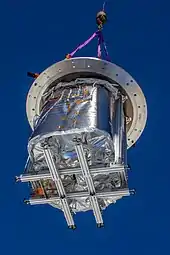GroundBIRD
GroundBIRD is an experiment to observe the cosmic microwave background at 145 and 220GHz. It aims to observe the B-mode polarisation signal from inflation in the early universe. It is located at Teide Observatory, on the island of Tenerife in the Canary Islands.
 GroundBIRD in 2019 | |
| Part of | Teide Observatory |
|---|---|
| Location(s) | Tenerife, Atlantic Ocean, international waters |
| Coordinates | 28°18′02″N 16°30′37″W |
| Altitude | 2,400 m (7,900 ft) |
| Wavelength | 145, 220 GHz (2.07, 1.36 mm) |
| Telescope style | cosmic microwave background experiment radio telescope |
| Diameter | 30 cm (1 ft 0 in) |
| Angular resolution | 0.5 degree, 0.3 degree |
 Location of GroundBIRD | |
| | |
Scientific goals
The telescope was constructed to measure the B-mode signal in the polarisation of the Cosmic Microwave Background (CMB),[1] in order to look for evidence of cosmic inflation in the early universe. It aims to observe the reionization bump at and the recombination peak around .[2] The name 'GroundBIRD' indicates that the telescope is ground-based, while BIRD stands for B-mode Imaging Radiation Detector.[2] It is related to the future, similarly-named, LiteBIRD CMB satellite.
Telescope

The telescope consists of two mirrors in a Mizuguchi-Dragone configuration, with a diameter of 30 cm (12 in). The telescope is inside the cryostat, which is mounted on a rotation table, with a rotary joint that provides helium gas and electricity to the cryostat.[2][3] The mirrors are cooled to 4 K (−269.15 °C) using a Pulse tube refrigerator to reduce the thermal noise from the mirror surfaces.[2]
The experiment uses microwave kinetic inductance detectors (MKIDs),[4] which are cooled to 250mK by a sorption cooler within the cryostat, which uses helium-3, and was manufactured by Chase Research Cryogenics Ltd.[2] The signals from the detector are multiplexed, and around 100 detectors can be measured in both phase and amplitude with a single digital read-out system with a bandwidth of 200MHz, recording 1,000 samples per second. The digital system uses 12-bit ADCs and a Kintex-7 FPGA from Xilinx initially,[4] and now uses Kintex ultrascale FPGAs. Raspberry Pis are used to monitor and control the telescope.[5]
The cryostat rotates at 20 rpm (120° per second, 1 rotation every 3 seconds) to minimize 1/f noise.[2][6][7] It observes at zenith angles up to 20°, mapping around 40% of the sky. The field of view is 10°, with an angular resolution of 0.5° FWHM at 145GHz, and 0.3° at 220GHz.[2] It will measure the CMB at [6]
The telescope was constructed at KEK in Japan.[2] Test observations started in Japan in 2014. While it was originally intended that it would observe from the Atacama Desert in Chile,[6] an agreement to install it at Teide Observatory was reached in 2016,[8][1][9] at an altitude of 2,400 metres (7,900 ft).[2][10] It was shipped to Tenerife in January 2019.[7] In February 2020, the experiment was visited by Kenji Hiramatsu, the Japanese Ambassador to Spain.[11]
Collaboration

The collaboration includes scientists from:
- Delft University of Technology, Netherlands[2]
- The Graduate University for Advanced Studies, Japan[4]
- Korea Astronomy and Space Science Institute, Korea[2][12]
- Instituto de Astrofísica de Canarias, Canary Islands, Spain[2]
- KEK, Japan[2]
- Korea University, Korea[2]
- Kyoto University, Japan[2]
- National Astronomical Observatory of Japan, Japan[2]
- RIKEN, Japan[2]
- Saitama University, Japan[2]
- Tohoku University, Japan[2]
- University of Tokyo, Japan[2]
Funding

The project is funded by:
- Ministry of Education, Culture, Sports, Science and Technology, Japan[4][6]
- The Graduate University for Advanced Studies, Japan[6]
- National Astronomical Observatory of Japan, Japan[6]
- National Research Foundation of Korea, Korea[6]
with additional support from:
References
- PROVINCIA, LA (16 December 2016). "Tenerife suma un telescopio para buscar la huella del 'Big Bang' en el Universo". La Provincia - Diario de Las Palmas (in Spanish). Retrieved 16 November 2020.
- Choi, J.; Génova-Santos, R.; Hattori, M.; Hazumi, M.; Ishitsuka, H.; Kanno, F.; Karatsu, K.; Kiuchi, K.; Koyano, R.; Kutsuma, H.; Lee, K.; Mima, S.; Minowa, M.; Nagai, M.; Nagasaki, T.; Naruse, M.; Oguri, S.; Okada, T.; Otani, C.; Rebolo, R.; Rubiño-Martín, J.; Sekimoto, Y.; Suzuki, J.; Taino, T.; Tajima, O.; Tomita, N.; Uchida, T.; Won, E.; Yoshida, M. (2018). "Status of the GroundBIRD Telescope". EPJ Web of Conferences. 168: 01014. Bibcode:2018EPJWC.16801014C. doi:10.1051/epjconf/201816801014. ISSN 2100-014X.
- "ロータリージョイント | TKD(株)武田エンジニアリング". www.takeda-eng.jp.
- Ishitsuka, H.; Ikeno, M.; Oguri, S.; Tajima, O.; Tomita, N.; Uchida, T. (13 January 2016). "Front–End Electronics for the Array Readout of a Microwave Kinetic Inductance Detector Towards Observation of Cosmic Microwave Background Polarization". Journal of Low Temperature Physics. 184 (1–2): 424–430. Bibcode:2016JLTP..184..424I. doi:10.1007/s10909-015-1467-7. S2CID 111807277.
- "GroundBIRD telescope". The MagPi magazine. Retrieved 9 August 2022.
- Oguri, S.; Choi, J.; Hazumi, M.; Kawai, M.; Tajima, O.; Won, E.; Yoshida, M. (28 February 2014). "GroundBIRD Experiment: Detecting CMB Polarization Power in a Large Angular Scale from the Ground". Journal of Low Temperature Physics. 176 (5–6): 691–697. Bibcode:2014JLTP..176..691O. doi:10.1007/s10909-014-1138-0. S2CID 121462368.
- "茨城)宇宙の膨張、証拠を探せ 原子重力波観測に新装置:朝日新聞デジタル". 朝日新聞デジタル (in Japanese). Retrieved 16 November 2020.
- "Japón buscará evidencias del Big Bang desde el Observatorio del Teide". The Diplomat in Spain. 9 January 2017. Retrieved 16 November 2020.
- S.L, Titania Cía Editorial. "Experimento japonés se suma en Canarias a buscar primeros pasos del Universo - Miércoles, 14 Diciembre 2016 20:16". El Confidencial (in Spanish). Retrieved 16 November 2020.
- INC, SANKEI DIGITAL (27 January 2019). "【クローズアップ科学】原始重力波の証拠を探せ 宇宙誕生の謎、日本も本格観測". 産経ニュース (in Japanese). Retrieved 16 November 2020.
- Time, El. "El embajador de Japón en España visita el Roque de Los Muchachos". El Time (in European Spanish). Retrieved 16 November 2020.
- "Department Information | KASI". www.kasi.re.kr. Retrieved 26 August 2020.
- "About OpenIt — Open-It". openit.kek.jp. Retrieved 20 December 2019.